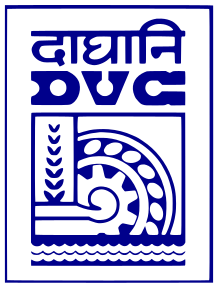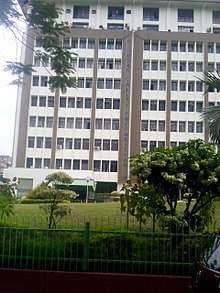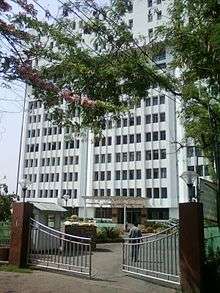Damodar Valley Corporation
Damodar Valley Corporation (DVC) is an Indian governmental organization which operates in the Damodar River area of West Bengal and Jharkhand states of India. The corporation operates both thermal power stations and hydel power stations under the Ministry of Power, Govt of India. DVC is headquartered in the city of Kolkata, West Bengal, India.[1]
 | |
| Government of India Statutory Body | |
| Industry | Utilities (energy) |
| Founded | 7 July 1948 |
| Headquarters | Kolkata, West Bengal, India |
Key people | Shri Gurdeep Singh (Chairman) |
| Products | Electricity |
| Services | Electricity generation and Transmission, distribution, production, Soil conservation Flood Moderation |
Number of employees | 6800 (2020) |
| Website | www |

History
DVC emerged as a culmination of attempts made over a whole century to control the wild and erratic Damodar River. The valley has been ravaged frequently by floods at varying intensities. Serious floods occurred in 1730, 1823, 1848, 1856, 1882, 1898, 1901, 1916, 1923, 1935 & 1943. The river spans over an area of 25,235 sq. km covering the states of Bihar (now Jharkhand) & West Bengal. The catastrophe caused by the 1943 flood, led to serious public indignation against the Government. As a result, the Government of Bengal appointed a board of Enquiry titled "Damodar Flood Enquiry Committee"with the Maharaja of Burdwan and the noted physicist Dr. Meghnad Saha as members for suggesting remedial measures.
The Damodar Flood Enquiry Committee suggested the creation of an authority similar to the Tennessee Valley Authority in the USA and recommended the construction of dams and storage reservoirs at the sites with a total capacity of 1.5 million acre-ft. (1.850 million cu. M) and highlighted the possibilities of multipurpose development in the valley area. The Government of India then commissioned the ‘Central Technical Power Board’ to study the proposal and appointed Mr. W L Voorduin, a senior engineer of the TVA to study the problem at the Damodar and to make his recommendation for comprehensive development of the valley. Accordingly, in August 1944 Mr. W L Voorduin submitted his ‘Preliminary Memorandum on the unified Development of the Damodar River.’
Mr. Voorduin's "Preliminary Memorandum" suggested a multipurpose development plan designed for achieving flood control, irrigation, power generation and navigation in the Damodar Valley. Four consultants appointed by the Government of India examined it. They also approved the main technical features of Voorduin's scheme and recommended early initiation of construction beginning with Tilaiya to be followed by Maithon. By April 1947, full agreement was practically reached between the three Governments of Central, West Bengal and Bihar on the implementation of the scheme and in March 1948, the Damodar Valley Corporation Act (Act No. XIV of 1948) was passed by the Central Legislature, requiring the three Governments, The Central Government and the State Governments of West Bengal and Bihar to participate jointly for the purpose of building the Damodar Valley Corporation. The Corporation came into existence on 7 July 1948 as the first multipurpose river valley project of independent India.
Command area: 24,235 km2 spread across the Damodar basin. Jharkhand: 2 districts fully (Dhanbad and Bokaro) and parts of 8 districts (Hazaribagh, Koderma, Chatra, Palamau, Ranchi, Revanth Loherdaga, Giridih, and Dumka) West Bengal: 6 districts (Purba Bardhhaman, Paschim Bardhhaman, Hoogly, Howrah, Bankura, Purulia)
The Damodar Valley Corporation has been generating and transmitting power since 1953.
DVC plants
| Power Plant Name | State | Installed Capacity in MW | Remarks |
|---|---|---|---|
| Mejia Thermal Power Station | West Bengal | 2,340 | |
| Raghunathpur Thermal Power Station | West Bengal | 1,200 | |
| Maithon Power Limited | Jharkhand | 1,050 | Owned by Maithon Power Limited a joint venture between DVC and Tata Power [4] |
| Durgapur Steel Thermal Power Station | West Bengal | 1,000 | |
| Koderma Thermal Power Station | Jharkhand | 1,000 | |
| Chandrapura Thermal Power Station | Jharkhand | 500 | |
| Bokaro Thermal Power Station - B | Jharkhand | 210 | |
| Bokaro Thermal Power Station - A | Jharkhand | 500 | |
| Durgapur Thermal Power Station | West Bengal | 210 | |
| BPSCL Power Plant | Jharkhand | 338 | Owned by Bokaro Power Supply Corporation Limited (BPSCL) a joint venture between DVC and Bokaro Steel Limited [5] |
| Total | 7107 | ||
| Power Plant Name | State | Installed Capacity in MW |
|---|---|---|
| Panchet Dam | Jharkhand | 80 |
| Maithon Dam | Jharkhand | 63.2 |
| Tilaiya Dam | Jharkhand | 4 |
| Total | 147 | |
Infrastructure

DVC developed and expanded its infrastructure to six thermal power stations'(7410 MW)'and three hydro-electric power stations with a capacity of 147.2 MW which contribute to a total installed capacity of 7557.2 MW. Presently DVC has 49 sub-stations and receiving stations more than 8900-circuit km of transmission and distribution lines. DVC has also four dams, a barrage and a network of canals (2494 km) that play an effective role in water management. The construction of check dams, development of forests and farms and upland and wasteland treatment developed by DVC play a vital role in eco conservation and environment management.
Water Management Overview
DVC has a network of four dams - Tilaiya and Maithon on Barakar River, Panchet on Damodar river and Konar on Konar river. Besides, Durgapur barrage and the canal network, handed over to the Government of West Bengal in 1964, remained a part of the total system of water management. DVC dams are capable of moderating floods of 6.51 lac cusec to 2.5 lac cusecs.
Four multipurpose dams were constructed during the period 1948 to 1959.
Flood reserve capacity of 1,292 mcm has been provided in 4 reservoirs, which can moderate a peak flood of 18,395 cumecs to a safe carrying capacity of 7,076 cumecs. 419 mcm of water is stored in the 4 DVC reservoirs to supply 680 cusecs of water to meet industrial, municipal and domestic requirements in West Bengal & Jharkhand. The Durgapur barrage on river Damodar was constructed in 1955 for the supply of irrigation water to the districts of Burdwan, Bankura & Hooghly.
- Irrigation Command Area (Gross): 569,000 hectares (5,690 km2)
- Irrigation Potential Created: 364,000 hectares (3,640 km2)
- Canals: 2,494 km (1,550 mi)
30,000 hectares (300 km2) of land in the upper valley is being irrigated, every year by lift irrigation with the water available from 16,000 (approx) check dams constructed by DVC.
Joint venture projects
- Maithon Power Limited
A joint venture company by DVC and Tata Power has been formed to implement 1,050 MW Maithon Right Bank Thermal Power Project for meeting the energy needs of power deficient regions on export basis.
- Bokaro Power Supply Corporation Limited (BPSCL)
A joint venture of DVC and SAIL has been established to operate and maintain the captive power and steam generation plant, hived off by SAIL and its Bokaro Steel Plant and supply power and steam exclusively to Bokaro Steel Ltd.
- DVC EMTA Coal Mines Limited
A joint venture company formed with Eastern Minerals & Trading Agency for development and operation of Captive Coal Mine Blocks and supply of coal exclusively to DVC Thermal Power Projects of 10th and 11th plan.
- Mining & Allied Machinery Corporation (MAMC)
The Mining and Allied Machinery Corporation (MAMC) in Durgapur —one of the PSU's in India set up under the rupee-rouble agreement and enjoying Soviet patronage in the early sixties. Bharat Earth Movers has the highest stake (48%) in the consortium while the other two PSUs — DVC and Coal India — have 26% stake each.
Notes
- "DVC". Archived from the original on 10 February 2007. Retrieved 23 October 2006.
- "Generating Units". report. DVC. Archived from the original on 8 December 2015. Retrieved 8 July 2016.
- "Generating Units". DVC. Archived from the original on 27 February 2014.
- "Power puffed by Maithon 1050MW Tata-DVC plant chugs to life".
- "The Official Website of BPSCL".
External links
| Wikimedia Commons has media related to Damodar Valley Corporation. |